Micro Fracture Behavior of Composite Honeycomb Sandwich Structure
Abstract
:1. Introduction
2. Structural Design and Material Model
2.1. Structural Design
2.2. Material Model
2.3. Calculation of Fracture Energy of Composite Honeycomb Structure
3. Impact Resistance Analysis of Composite Double-Layer Honeycomb Structure
4. Conclusions
- (1)
- It is feasible to use TrueGrid software to divide finite element mesh and densified mesh. The finite-element mesh with high-quality mesh can be obtained. The method of increasing the number of iterations can obtain satisfactory numerical simulation results. The proposed method for calculating the fracture energy of the composite honeycomb sandwich structure can well describe the deformation trend and damage of the structure in each time period, especially for the judgment of the skin fracture time.
- (2)
- Cell density is one of the main factors affecting the fracture energy of composite honeycomb structure. With the increase of cell density, the greater the fracture energy, but the influence of cell density is less than that of material strength.
- (3)
- When the material and structure size of the aluminum core layer are the same, the ratio of the fracture energy in the 4340 steels area is the same as the ratio of the cell diameter in this area.
- (4)
- In the eight kinds of structures, under the same structural size, the structure with 4340 steel on the top layer has a larger energy per mass and energy per volume absorption than the structure with 4340 steel on the bottom layer. The maximum energy per mass and energy per volume are 53.567 J/g and 167.867 J/cm3, which are 9.98% and 23.77% higher than the traditional aluminum honeycomb structure.
Author Contributions
Funding
Data Availability Statement
Conflicts of Interest
References
- Bai, R.; Ou, H.; Peng, K. Failure study of honeycomb sandwich structure with embedded part under axial pullout loading. Thin-Wall. Struct. 2019, 146, 106489. [Google Scholar] [CrossRef]
- Xie, S.; Wang, D.; Feng, Z. Sound absorption performance of microperforated honeycomb metasurface panels with a combination of multiple orifice diameters. Appl. Acoust. 2020, 158, 107046. [Google Scholar] [CrossRef]
- Aumjaud, P.; Fieldsend, J.E.; Boucher, M.A. Multi-objective optimisation of viscoelastic damping inserts in honeycomb sandwich structures. Compos. Struct. 2015, 132, 451–463. [Google Scholar] [CrossRef] [Green Version]
- Palomba, G.; Crupi, V.; Epasto, G. Collapse modes of aluminium honeycomb sandwich structures under fatigue bending loading. Thin-Wall. Struct. 2019, 145, 106363. [Google Scholar] [CrossRef]
- Namvar, A.R.; Vosoughi, A.R. Design optimization of moderately thick hexagonal honeycomb sandwich plate with modified multi-objective particle swarm optimization by genetic algorithm (MOPSOGA). Compos. Struct. 2020, 252, 112626. [Google Scholar] [CrossRef]
- Gholami, M.; Alashti, R.A.; Fathi, A. Optimal design of a honeycomb core composite sandwich panel using evolutionary optimization algorithms. Compos. Struct. 2016, 139, 254–262. [Google Scholar] [CrossRef]
- Martinez-Martin, F.J.; Thrall, A.P. Honeycomb core sandwich panels for origami-inspired deployable shelters: Multi-objective optimization for minimum weight and maximum energy efficiency. Eng. Struct. 2014, 69, 158–167. [Google Scholar] [CrossRef]
- Lim, Y.W.; Choi, H.J.; Idapalapati, S. Design of Alporas aluminum alloy foam cored hybrid sandwich plates using Kriging optimization. Compos. Struct. 2013, 96, 17–28. [Google Scholar] [CrossRef]
- Palomba, G.; Epasto, G.; Crupi, V. Single and double-layer honeycomb sandwich panels under impact loading. Int. J. Impact Eng. 2018, 121, 77–90. [Google Scholar] [CrossRef]
- Qin, Q.H.; Zheng, X.Y.; Zhang, J.X. Dynamic response of square sandwich plates with a metal foam core subjected to low-velocity impact. Int. J. Impact Eng. 2018, 111, 222–235. [Google Scholar] [CrossRef]
- Liu, J.; He, W.; Xie, D. The effect of impactor shape on the low-velocity impact behavior of hybrid corrugated core sandwich structures. Compos. Part B Eng. 2017, 111, 315–331. [Google Scholar] [CrossRef]
- Qin, Q.; Chen, S.; Li, K. Structural impact damage of metal honeycomb sandwich plates. Compos. Struct. 2020, 252, 112719. [Google Scholar] [CrossRef]
- Sibeaud, J.M.; Thamie, L.; Puillet, C. Hypervelocity impact on honeycomb target structures: Experiments and modeling. Int. J. Impact Eng. 2008, 35, 1799–1807. [Google Scholar] [CrossRef]
- Zhang, J.H.; Zhu, X.F.; Yang, X.D. Transient Nonlinear Responses of an Auxetic Honeycomb Sandwich Plate under Impact Loads. Int. J. Impact Eng. 2019, 134, 103383. [Google Scholar] [CrossRef]
- Pydah, A.; Batra, R.C. Blast loading of bumper shielded hybrid two-core Miura-ori/honeycomb core sandwich plates. Thin-Wall. Struct. 2018, 129, 45–57. [Google Scholar] [CrossRef]
- Theobald, M.D.; Langdon, G.S.; Nurick, G.N. Large inelastic response of unbonded metallic foam and honeycomb core sandwich panels to blast loading. Compos. Struct. 2010, 92, 2465–2475. [Google Scholar] [CrossRef]
- Rogério, C.; Paccola, R.R.; Coda, H.B. Vibration and stress analysis of orthotropic laminated panels by active face prismatic finite element. Compos. Struct. 2020, 244, 112254. [Google Scholar]
- Wang, Y.J.; Zhang, Z.J.; Xue, X.M. Free vibration analysis of composite sandwich panels with hierarchical honeycomb sandwich core. Thin-Wall. Struct. 2019, 145, 106425. [Google Scholar] [CrossRef]
- Li, Y.Q.; Zhou, M.; Wang, T. Nonlinear primary resonance with internal resonances of the symmetric rectangular honeycomb sandwich panels with simply supported along all four edges. Thin-Wall. Struct. 2020, 147, 106480. [Google Scholar] [CrossRef]
- Felipe, D.S.E.; Ferreira, G.G.; Carlos, A.A. Experimental dynamic analysis of composite sandwich beams with magnetorheological honeycomb core. Eng. Struct. 2018, 176, 231–242. [Google Scholar]
- Reyno, T.; Marsden, C.; Wowk, D. Surface damage evaluation of honeycomb sandwich aircraft panels using 3D scanning technology. NDT E Int. 2018, 97, 11–19. [Google Scholar] [CrossRef]
- Ma, G.; He, G.; Liu, Y. Study of the Forming Characteristics of Small-Caliber Ammunition with Circumferential MEFP. Materials 2020, 13, 891. [Google Scholar] [CrossRef] [PubMed] [Green Version]
- Zhang, T.; Wei, Q.; Hou, Z. Review of Numerical Simulation Methods for Hypervelocity Impact of Space Debris. Mater. Rep. 2017, 31, 438–442. [Google Scholar]
- Gao, D.; Wang, Z.; Qian, W. Fracture energy and crack opening displacement of steel fiber reinforced high strength concrete. J. Chin. Ceram. Soc. 2006, 34, 193–198. [Google Scholar]
- Xie, W.; Zhang, W.; Kuang, N. Experimental investigation of normal and oblique impacts on CFRPs by high velocity steel sphere. Compos. Part B Eng. 2016, 9, 483–493. [Google Scholar] [CrossRef]

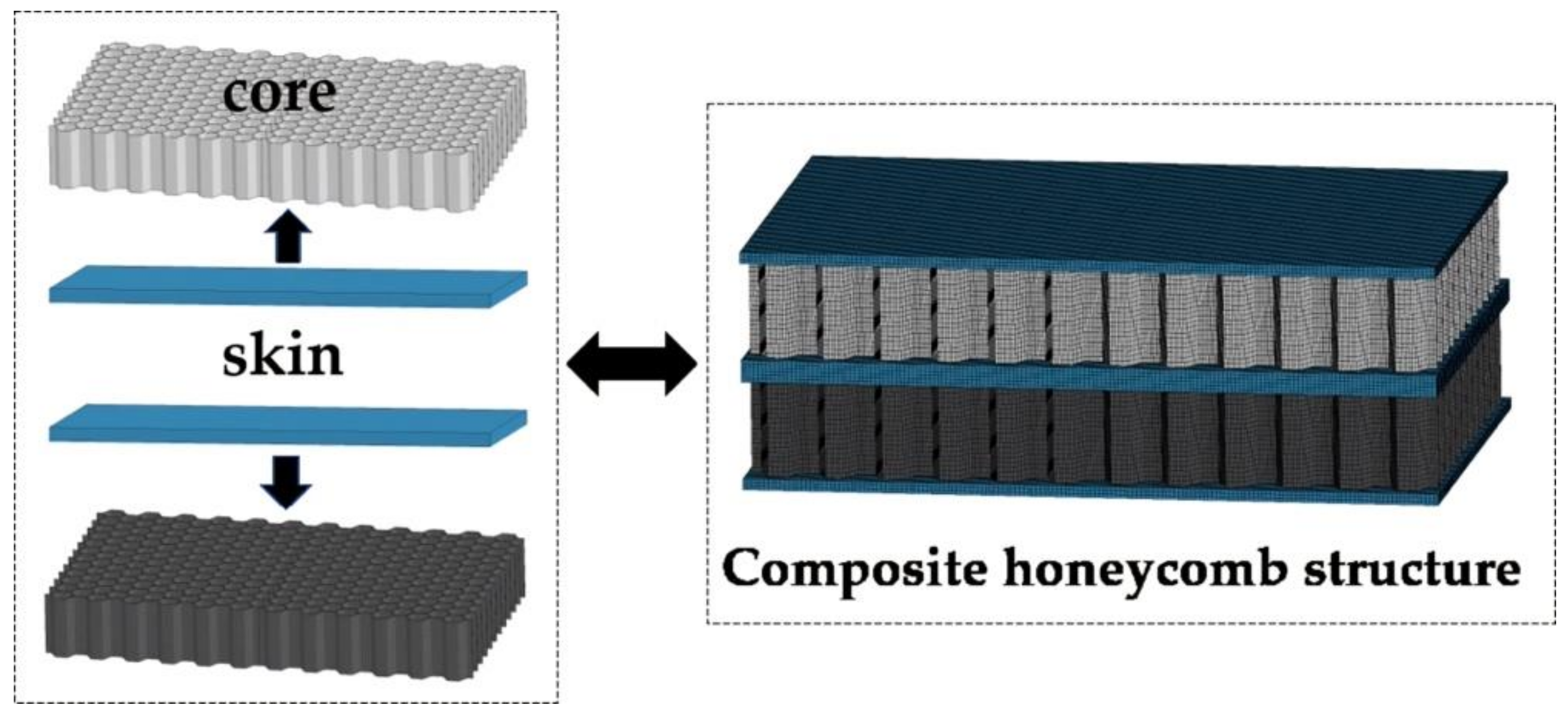
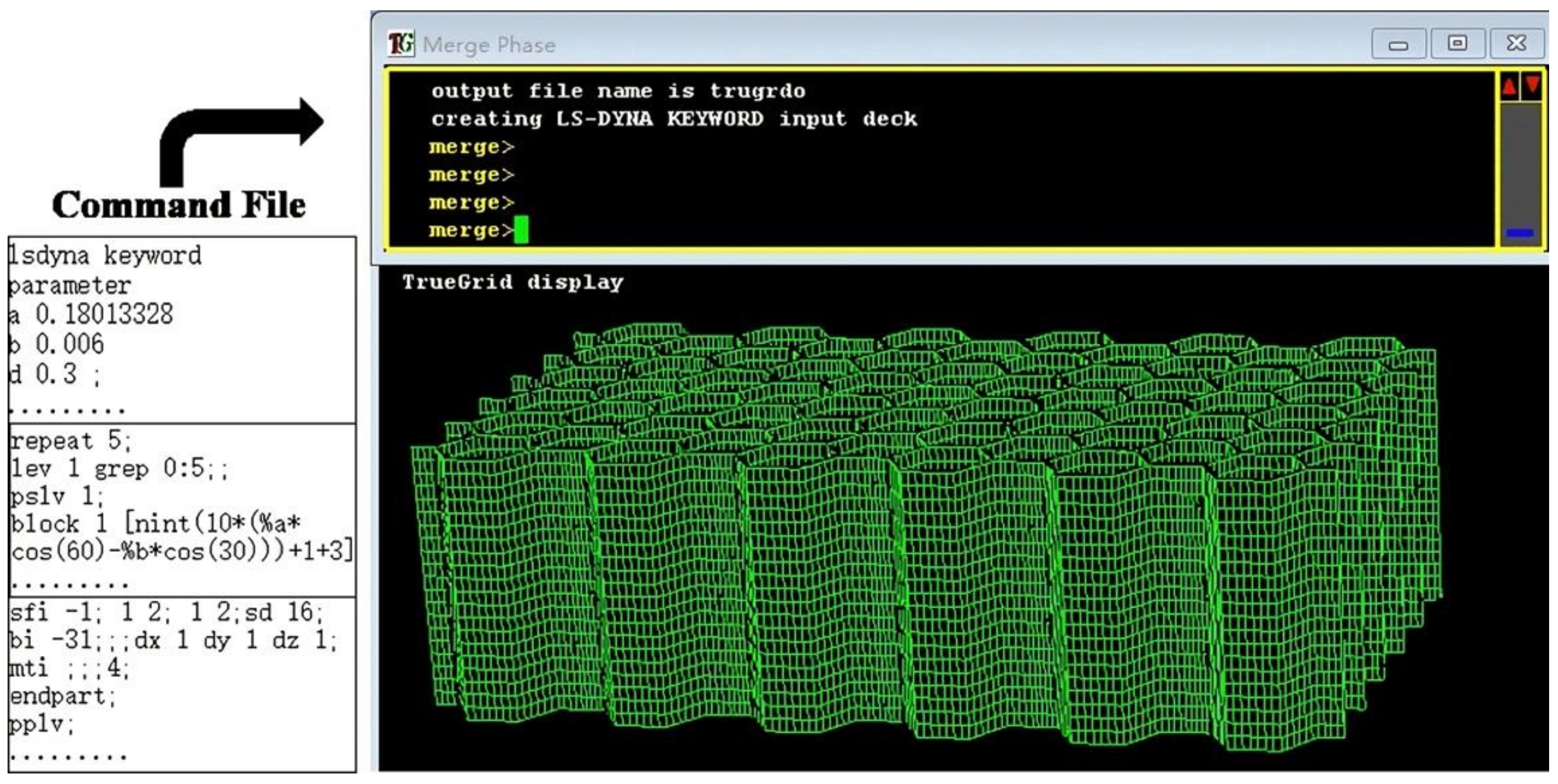
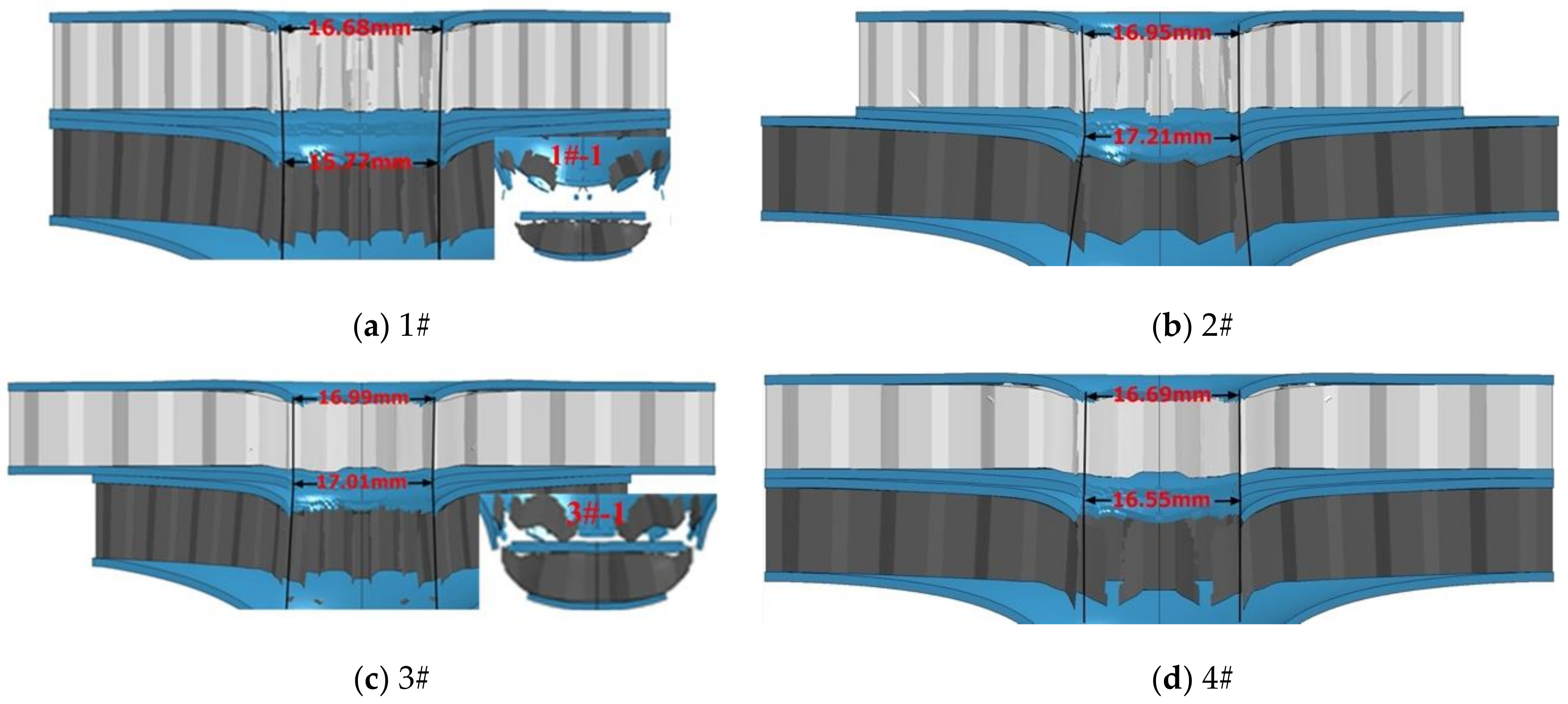


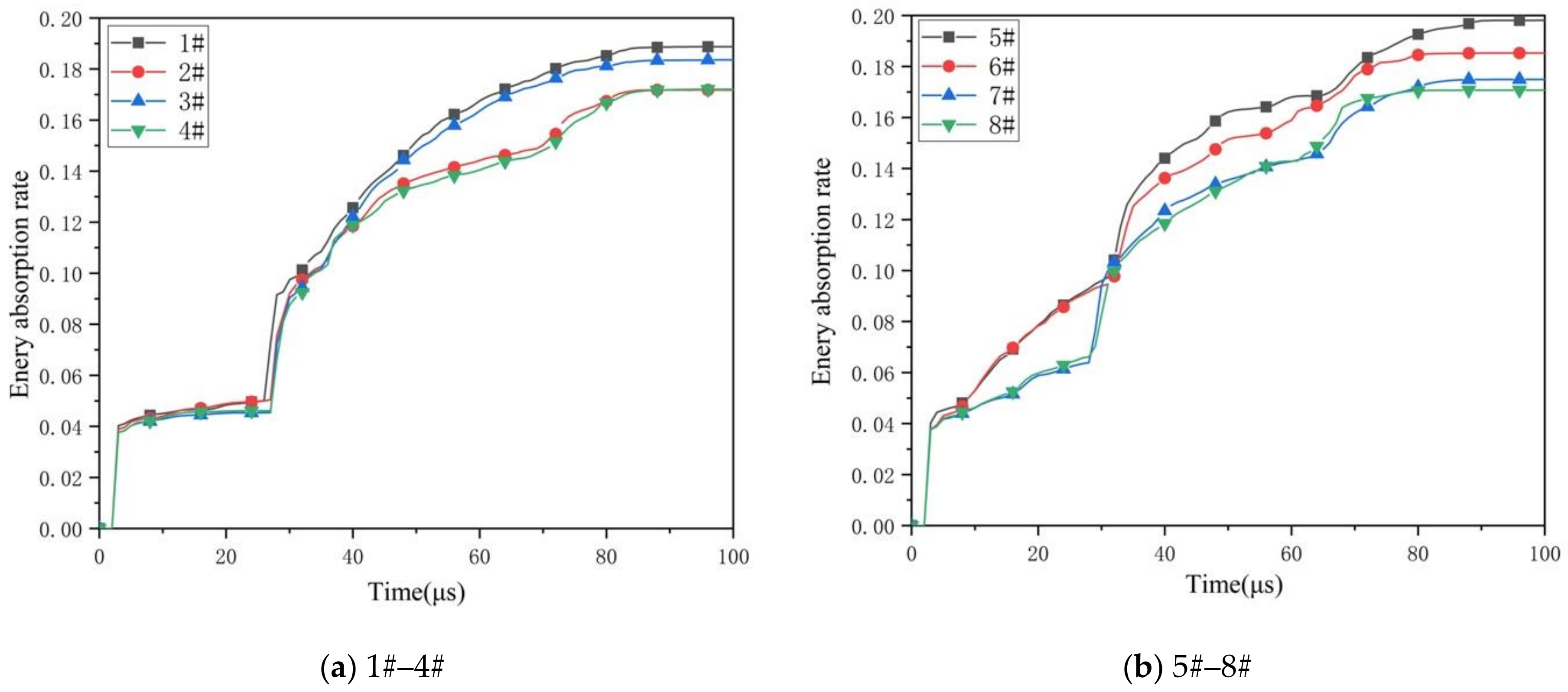
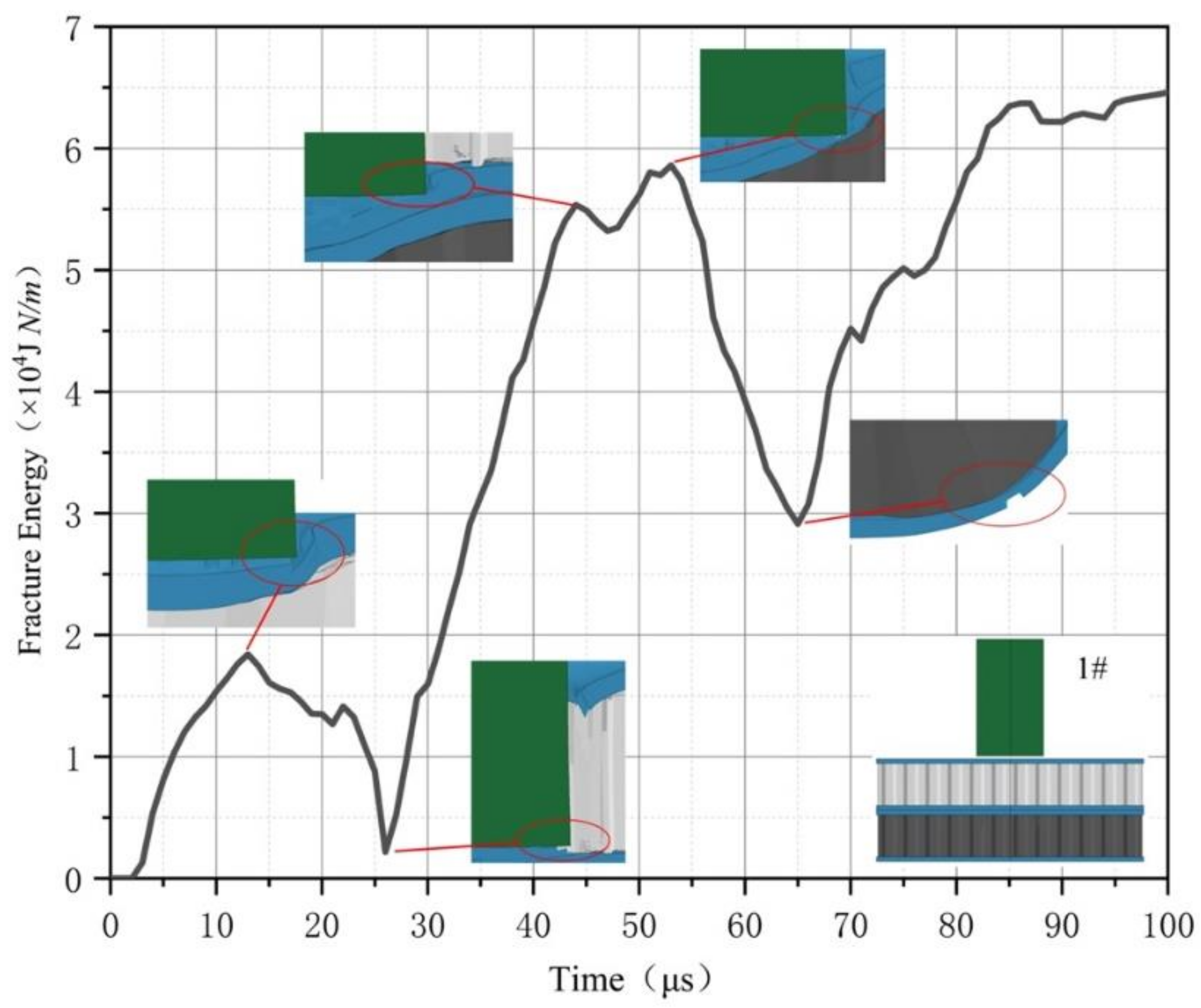
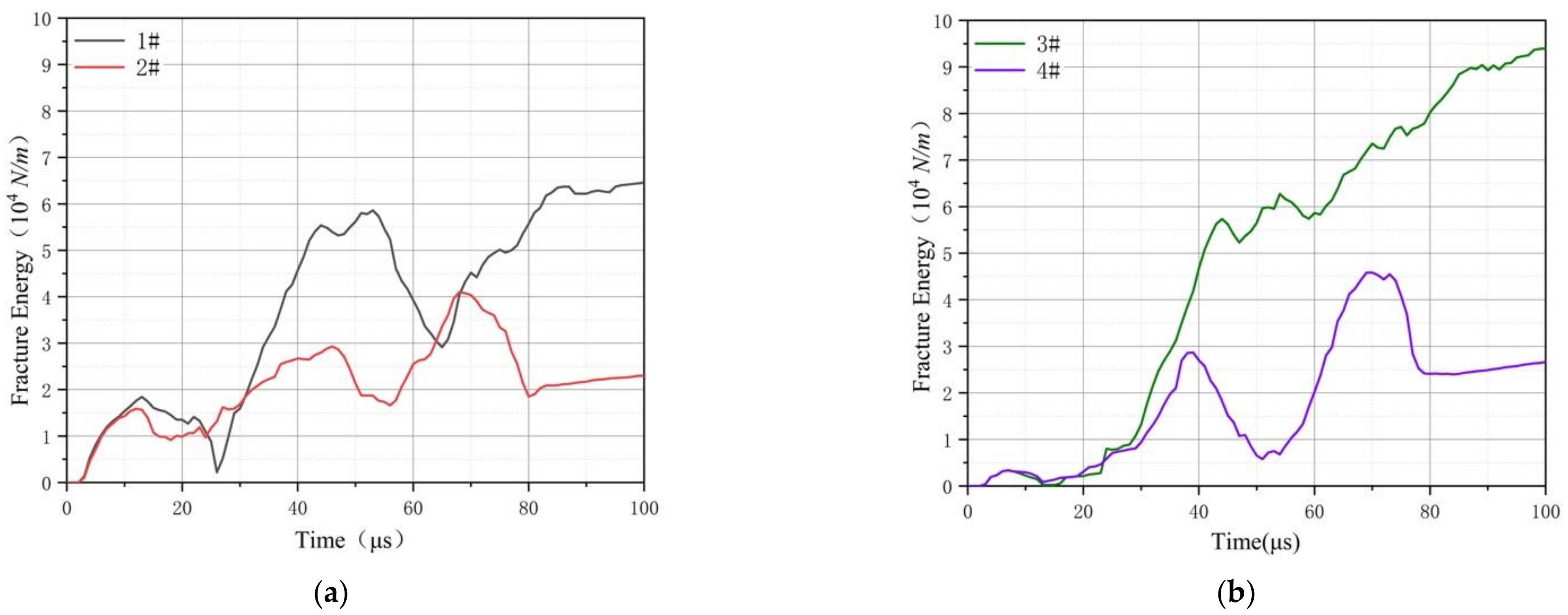

| D (mm) | a × b (mm2) | e (mm) | c (mm) | h (mm) | F (mm) |
|---|---|---|---|---|---|
| 3 | 64 × 40 | 1 | 9 | 11 | 0.06 |
| 6 | 84 × 50 | 1 | 9 | 11 | 0.06 |
| Skin | Scheme | Materials | Top | Bottom | Scheme | Materials | Top | Bottom |
|---|---|---|---|---|---|---|---|---|
| Aluminum | 1# | Al/St | D = 3 mm | D = 3 mm | 5# | St/Al | D = 3 mm | D = 3 mm |
| 2# | Al/St | D = 3 mm | D = 6 mm | 6# | St/Al | D = 3 mm | D = 6 mm | |
| 3# | Al/St | D = 6 mm | D = 3 mm | 7# | St/Al | D = 6 mm | D = 3 mm | |
| 4# | Al/St | D = 6 mm | D = 6 mm | 8# | St/Al | D = 6 mm | D = 6 mm |
| Material | ρ (g/cm3) | G (GPa) | A (GPa) | B (GPa) | n | C | m | Tm (K) | Tr (K) |
|---|---|---|---|---|---|---|---|---|---|
| 2024 Aluminum | 2.785 | 28.6 | 0.265 | 4.26 | 0.34 | 0.015 | 1.00 | 775 | 300 |
| 4340 Steel | 7.83 | 77 | 0.792 | 0.51 | 0.26 | 0.014 | 1.03 | 1793 | 300 |
| Scheme | Energy Per Mass (J/g) | Energy Per Volume (J/cm3) | Scheme | Energy Per Mass (J/g) | Energy Per Volume (J/cm3) |
|---|---|---|---|---|---|
| 1# | 46.596 | 146.021 | 5# | 53.567 | 167.867 |
| 2# | 32.552 | 98.553 | 6# | 41.368 | 126.590 |
| 3# | 37.420 | 114.509 | 7# | 36.437 | 110.315 |
| 4# | 26.462 | 78.920 | 8# | 29.069 | 86.778 |
Publisher’s Note: MDPI stays neutral with regard to jurisdictional claims in published maps and institutional affiliations. |
© 2020 by the authors. Licensee MDPI, Basel, Switzerland. This article is an open access article distributed under the terms and conditions of the Creative Commons Attribution (CC BY) license (http://creativecommons.org/licenses/by/4.0/).
Share and Cite
Bi, G.; Yin, J.; Wang, Z.; Jia, Z. Micro Fracture Behavior of Composite Honeycomb Sandwich Structure. Materials 2021, 14, 135. https://doi.org/10.3390/ma14010135
Bi G, Yin J, Wang Z, Jia Z. Micro Fracture Behavior of Composite Honeycomb Sandwich Structure. Materials. 2021; 14(1):135. https://doi.org/10.3390/ma14010135
Chicago/Turabian StyleBi, Guangjian, Jianping Yin, Zhijun Wang, and Zijian Jia. 2021. "Micro Fracture Behavior of Composite Honeycomb Sandwich Structure" Materials 14, no. 1: 135. https://doi.org/10.3390/ma14010135
APA StyleBi, G., Yin, J., Wang, Z., & Jia, Z. (2021). Micro Fracture Behavior of Composite Honeycomb Sandwich Structure. Materials, 14(1), 135. https://doi.org/10.3390/ma14010135






